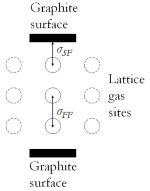EPJ B Highlight - Trapping climate pollutant methane gas in porous carbon
- Details
- Published on 01 December 2015

New adsorption of gas into porous carbon simulations are of interest to energy research and climate change mitigation
As talks of global warming are once again making headlines, scientists have renewed their efforts to understand how to best limit its effects. For example, sequestrating short-lived climate pollutants, such as methane and black carbon, yields much faster reductions in global warming compared to reductions in CO2. To do so, it is essential to have a better grasp of the nature of physico-chemical properties of gases interacting with porous carbon. Now, a team of chemical engineering researchers based in South Africa has established ways of accurately simulating methane adsorption and desorption in carbon with nanopores. These findings have been published by Matthew Lasich and Deresh Ramjugernath from the University of KwaZulu-Natal, Durban, South Africa, in EPJ B. Alternative applications for such findings are relevant for future energy research, such as energy storage and the development of natural gas extraction methods.
Activated carbon, which is a type of carbon material containing numerous nanopores, is often used to adsorb gases in the energy sector. The authors chose to use computational methods to study the influence of intermolecular interactions between different types of molecules - in this case, they simplified the approach by limiting it to methane and activated carbon - on adsorption. Their goal was to identify molecular interactions that could prevent such a process.
First, they employed a standard simulation approach, which was dubbed grand canonical Monte Carlo simulations. Parallel to that, they used a simple lattice gas model coupled with equations describing the intermolecular interactions, otherwise referred to as classical density functional theory. They found that both approaches yielded qualitative agreement with previously published experimental data. However, the second approach yielded results more in line with experimental data for gases adsorbed into carbon materials when equations are amended through simple corrections pertaining to energy levels, rather than by corrections related to the difference in the size of the various molecules involved.
M. Lasich and D. Ramjugernath (2015), Influence of unlike dispersive interactions on methane adsorption in graphite: A grand canonical Monte Carlo simulation and classical density functional theory study, Eur. Phys. J. B 88:313, DOI: 10.1140/epjb/e2015-60668-1





